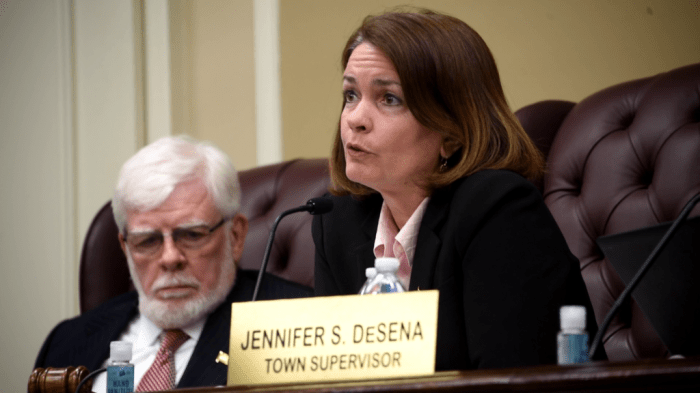
While some teenagers ended their carefree summer on the beach, Amanda Shirazi, Belle Lim, Raymond Lin and Ethan Abizadeh presented PowerPoints and answered questions about what they learned from partnering with scientists to research both breast cancer and the environment at Great Neck House on Aug. 30.
The program these students participated in, which was founded in 2005 by the Great Neck Breast Cancer Coalition (GNBCC), has sponsored 66 Nassau County and New York City internships for high schoolers at 10 research facilities in the Northeast.

In addition, GNBCC and the 2018 students plan to attend the federally funded annual Breast Cancer and Environment Research Program Conference (BCERP) on Nov. 8 and 9 in Washington, DC.
“The students are submitting abstracts of their summer research to the BCERP Conference in order to partake in their national poster session,” said Laura Weinberg, GNBCC president. “To date, GNBCC has chaperoned over 25 high school students at the conference who have displayed posters of their research.”

Shirazi and Lim, both students at Great Neck North High School, interned with researcher Laura N. Vandenberg, PhD, along with other mentors in this lab. The interns examined the effects estrogenic chemicals, which can be found in consumer products such as Propylparaben (PP) and Oxybenzone (BP-3), have on mammary gland development in both prepubertal and pubertal mice.
Lim referred to her experience as eye-opening, while Shirazi said that working alongside Dr. Vandenberg was a once in a lifetime opportunity which taught her that research isn’t a quick process. Lim said that they learned, “…the answer isn’t always known to us at first.”
The interns gave a very informative presentation, in which they defined cancer as “abnormal cell growth.” A graphic depicted the five steps in cancer: The first is a healthy cell, which starts to develop damaged DNA in step two. Next, the cell becomes mutated, which paves the way for the now-mutated cell to begin unchecked reproduction. Finally, the mutated cells grow in number as the previous steps repeat.

Though many people believe that breast cancer is caused by genetics, Shirazi and Lim said that 95 percent of breast cancer cases are caused by environmental factors and carcinogens, such as pesticides, air pollutants, processed meat, tobacco and asbestos. Only 0.05 percent of breast cancer cases are caused by inherited genes. Lim showed that there are ways to be protected from these chemicals, like not smoking and using more environmentally friendly ways of keeping insects off lawns.

Lim and Shirazi’s presentation also defined Endocrine Disrupting Chemicals (EDCs) as “an endogenous [non-natural] chemical, or mixture of chemicals, that interferes with any aspect of hormone action.” They explained how people are exposed to EDCs all of the time in our homes, in our drinking water and in the air we breathe.

The interns showed examples of EDCs, such as DDT, a synthetic insecticide; DES, a form of synthetic estrogen which doctors prescribed to women during pregnancy, leaving many of their daughters infertile; dioxin, a chemical that increases risks of cancer, diabetes, Parkinson’s disease and heart disease; BPA, found in canned food, bottle lids and aerosol cans; and parabens, a class of widely used preservatives in cosmetic and pharmaceutical products.

Lin of Great Neck North High and Abizadeh of North Shore Hebrew Academy High School interned under the guidance of mentors at Dr. Richard Gross Laboratory at RPI. Lin said that he had unforgettable experiences and made invaluable friends at this lab. He and Abizadeh tested substances to help create bio-based food packaging film with antioxidant and antimicrobial properties, which would replace existing toxic chemicals in food packaging that are linked to breast cancer.

With help from mentors, Abizadeh said that he was able to learn the connection between biosurfactants and breast cancer prevention. He was able to act on this research by creating emulsions with different sophorolipid concentrations and seeing which emulsions worked better in food packaging.
Lin added that “through tireless work, [he has] found immense gratification in what [he’s] accomplished with green chemistry research.” Both plan to take the information they learned to continue conducting research in this field and fields related to it.

Their presentation reflected on what they did in the lab, the data they collected and information about what they were studying. Lin discussed the health risks and dangers of synthetic preservatives found in food packaging, which “prevent food spoilage through microbial or oxidative methods.” He said that BPA and perfluorooctanoic (PFOA) are both linked to breast cancer, while, “sorbates, nitrates, sulfites, formaldehydes and benzoates can cause undesirable health issues.”
Abizadeh explained their research goals while studying at the lab. They wanted to “develop a nontoxic, biocompatible alternative for common preservatives with similar antimicrobial and/or antioxidant properties.” They also wanted to “produce a food packaging film formulation using an emulsion of hydrophilic polymers, biosurfactants and essential oils.”

For the past three summers, Sayo Ogunleye of Sewanhaka High School interned with Dr. Mary Beth Terry of Columbia University Mailman School of Public Health. During her internships, she researched breast cancer risk and Vitamin D deficiency. She also conducted two research literature reviews, wrote an article/blog post aimed at teens about carcinogens in cosmetics and created publishing materials for teens about breast cancer. Ogunleye was unable to attend the presentation, as she was starting an exciting science program in college.

A tribute was given in her honor and local officials presented the students in attendance with citations to congratulate them on their work.
View previous interns’ research at www.greatneckbcc.org by clicking on Students and Scientists Essay.































